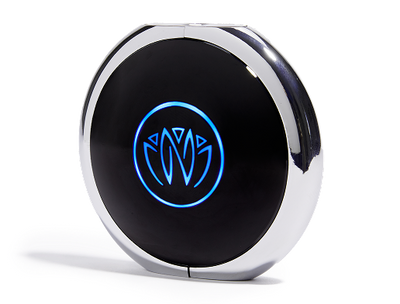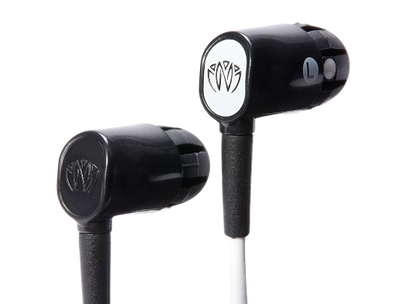Not all vagus nerve stimulation methods are created the same, and today we'll tell you all about an effective, non-invasive method called transcutaneous vagus nerve stimulation (tVNS). You'll learn about the benefits of tVNS and how it can help with common health conditions. Plus, we'll explain the science behind this cutting-edge therapy.
About Transcutaneous Vagus Nerve Stimulation
When it comes to treating medical conditions, surgical VNS has often been used. This involves having a pacemaker-like device implanted under the skin that sends electrical impulses to the vagus nerve. However, transcutaneous vagus nerve stimulation (tVNS) is a much less invasive method that can also be incredibly effective.
tVNS stimulates this critical nerve through the skin (or, often, through the ear) rather than through surgery. It's a minimally-invasive technique growing in popularity because it is safe, accessible, and effective.
One such method is using the Xen vagus nerve stimulation device. That way, you can target your nerve through your ear, a much more convenient option than undergoing surgery!
tVNS Benefits
Now, let's discuss the benefits of stimulating the vagus nerve transcutaneously and the benefits of vagus nerve stimulation in general.
Vagus nerve stimulation is effective in treating a variety of conditions, such as:
Depression and anxiety
Many people are discovering the benefits of transcutaneous vagus nerve stimulation for depression and anxiety. In fact, a study published in 2022 found that tVNS was as effective as antidepressants in treating patients with major depressive disorder.
Migraines and cluster headaches
If you experience migraines or cluster headaches, transcutaneous vagus nerve stimulation might be able to help. We'll talk more about pain and the vagus nerve later, but studies have shown that tVNS can effectively reduce both the frequency and severity of migraines.
Epilepsy
Transcutaneous vagus nerve stimulation has also been studied as a treatment for epilepsy. One 2018 study found tVNS to be effective for reducing seizure frequency in patients with refractory epilepsy. For most patients, tVNS was well tolerated with few side effects.
Many other potential benefits of transcutaneous vagus nerve stimulation are being studied, such as its ability to:
- Treat Alzheimer's disease
- Reduce inflammation
- Improve sleep quality
- Ease symptoms of fibromyalgia
- Relieve pain
As you can see, transcutaneous vagus nerve stimulation is a promising therapy with a wide range of potential benefits. So if you're looking for an effective, non-invasive way to treat a medical condition, tVNS might be worth considering.
Transcutaneous Vagus Nerve Stimulation To Help with Common Health Conditions
So, what about transcutaneous vagus nerve stimulation makes it so effective?
Modulating the autonomic nervous system
For one thing, tVNS has been shown to modulate the autonomic nervous system. This system controls involuntary functions like heart rate and blood pressure. By stimulating the vagus nerve transcutaneously, you can help to regulate these functions.
Your autonomic nervous system is made up of two parts: the sympathetic nervous system and the parasympathetic nervous system. Your sympathetic nervous system is responsible for what's known as the "fight or flight" response. On the other hand, your parasympathetic nervous system is responsible for the "rest and digest" response. When there's an imbalance between these two systems, it can contribute to a whole host of common health conditions, including depression and anxiety.
Transcutaneous vagus nerve stimulation helps balance these two systems. In particular, tVNS has been shown to activate the parasympathetic nervous system, which can help to reduce stress and promote relaxation.
Increasing neuroplasticity
Another reason transcutaneous vagus nerve stimulation is so effective is it can help to increase neuroplasticity. Neuroplasticity is the brain's ability to change and adapt in response to new experiences. Unfortunately, as we age, neuroplasticity decreases. This can lead to a decline in cognitive function and an increased risk of conditions like dementia.
Transcutaneous vagus nerve stimulation has been shown to increase neuroplasticity. This means that it might help to improve cognitive function and reduce the risk of dementia. This is one of the reasons tVNS is being studied as a potential treatment for Alzheimer's disease.
Activating different areas of the brain with transcutaneous vagus nerve stimulation
Transcutaneous vagus nerve stimulation also activates different areas of the brain. For example, one study found that tVNS was associated with increased activity in the prefrontal cortex, which is the part of the brain responsible for executive function.
But it isn't just the brain that transcutaneous vagus nerve stimulation can help to activate. tVNS has also been shown to increase heart rate variability. This is an important measure of cardiac health.
As you can see, transcutaneous vagus nerve stimulation has a wide range of potential benefits. So if you're looking for an effective, non-invasive way to treat a medical condition, tVNS might be worth considering.
Various Waveforms & Intensities for Effectiveness
Transcutaneous vagus nerve stimulation can be delivered in various waveforms, frequencies, and sensations, each of which has its own unique benefits. Therefore, the individual user must experiment with different settings to find what works best for them.
Here's a handy explanation of waveforms from our very own site:
"Think of them as the shape of the subtle stimulation you feel, the microsecond-long electrical pulses that define your experience. The waveforms represent the electrical energy delivered and its technical characteristics."
Sensations, on the other hand, are "patterns of waveforms repeated at specified time intervals. Like a volume knob on the radio, the sensation's function is to increase and decrease the intensity of stimulation throughout your session. (Hint: peaks match your selected intensity level!). Prefer a more gentle and gradual sensation? Start with Ocean Waves. Crave a faster-paced feel? Choose Cityscape. Whatever the moment calls for, experiment to find your sweet spot."
As for the frequency, this study explains:
"Non-invasive transcutaneous vagal nerve stimulation (tVNS) applies electrical current at a high frequency (typically, 25 Hz) through the left ear, targeting the auricular branch of the vagus nerve at the cymba conchae (Fig. 1; for anatomic evidence, see Van Bockstaele et al., 1999; Bermejo et al., 2017). tVNS has been shown to mimic the anticonvulsive and antidepressant effects of invasive VNS (Stefan et al., 2012; He et al., 2013; Hein et al., 2013; Bauer et al., 2016; Rong et al., 2016; Trevizol et al., 2016), and has demonstrated safety and tolerability (Redgrave et al., 2018)."
Brain Activation Research and Transcutaneous Vagus Nerve Stimulation
All kinds of ongoing research are being done into exactly how tVNS works, its potential, and what sorts of benefits it can provide.
Depression
For example, one area that shows promise but requires more study is how tVNS can benefit people with depression.
As this research from Frontiers in Neuroscience explains:
"The mechanism behind the therapeutic anti-depressive effects of VNS and tVNS is still unknown. In 2007, Kraus et al. investigated the acute brain activations of healthy subjects following tVNS through functional magnetic resonance imaging (fMRI), showing hypoactivation of the amygdala, hippocampus, parahippocampal gyrus, and middle and superior temporal gyrus, and hyperactivation in the insula, precentral gyrus, and thalamus (Kraus et al., 2007).
These cortical areas are connected both directly and indirectly to the nucleus tractus solitarii (NTS), which receives greatest afferent vagus input. The NTS relays incoming sensory information to the brain via an automatic feedback loop, direct projections to the reticular formation in the medulla, and ascending projections to the amygdala, insula, hypothalamus, thalamus, orbitofrontal cortex, and other limbic regions involved in anxiety and mood regulation via the parabrachial nucleus and the locus coeruleus (Mohr et al., 2011).
It is hypothesized that hypoactivation of the amygdala suppresses the hyperactive limbic brain areas, as seen in patients with depression (Mayberg, 1997), through projections from the amygdala to the amygdala–hippocampus–entorhinal cortex of the limbic system (Kraus et al., 2007)."
Tinnitus
The same report from Frontiers in Neuroscience also talks about the potential of tVNS for treating tinnitus:
"Recent imaging studies have suggested that chronic tinnitus is linked to a dysfunction in the auditory system, which results in abnormal neuronal behavior. Pairing of invasive vagus nerve stimulation with sound therapy has been shown to reverse tinnitus in rat models (Engineer et al., 2011), and so Lehtimäki et al. (2013) devised a pilot study to investigate whether tVNS could provide any therapeutic benefits for patients with chronic tinnitus. In addition, they also investigated whether tVNS could affect neuronal activity in the auditory cortex by imaging the brain using magnetoencephalography (MEG)."
The study's results found that, indeed, tVNS modulated the auditory cortical response. This suggests the auditory system can be accessed and modulated by tVNS.
High-confidence recognition memory
High-confidence recognition memory refers to the ability to remember something with a high degree of certainty. This is different from low-confidence recognition memory, where someone might remember something but not be entirely sure if it actually happened.
Interestingly, confidence in a memory is strongly linked with the accuracy of a memory. But what does this have to do with tVNS? Well, other brain activation research from 2020 has found that tVNS could improve high-confidence recognition memory:
"Whereas tVNS showed no effects on word processing, subtle effects on recollection-based memory performance emerged, which may indicate that tVNS facilitates hippocampus-mediated consolidation processes."
Pain
Finally, brain activation research into pain has also proven to be promising:
"Johnson et al. first attempted to study the effect of transcutaneous electrical stimulation of the ear on pain threshold in 1991, with a pilot study of 18 participants receiving low frequency burst stimulation at 2.3 Hz for 15 min on three different auricular sites (Johnson et al., 1991). In this study, pain threshold was noted to increase in 10 out of the 18 participants. Three participants also experienced a prolonged analgesic effect even after the stimulation device was turned off."
Not only is this exciting for people with chronic pain and conditions such as fibromyalgia, but it's also essential for understanding how pain and the brain work.
These are just three examples of the many potential benefits of transcutaneous vagus nerve stimulation. As research evolves, we will likely uncover more potential uses for this promising therapy.
Transcutaneous Vagus Nerve Stimulation: Conclusion
Transcutaneous vagus nerve stimulation (tVNS) is a promising new therapy with the potential to help with a variety of common health conditions. By stimulating the vagus nerve, tVNS can modulate the activity of various brain regions involved in mood, memory, pain, and more. While more research is needed to understand the full extent of its potential, transcutaneous vagus nerve stimulation shows promise as a safe and effective treatment for many different conditions.
If you're interested in learning more about transcutaneous vagus nerve stimulation or other new therapies, we encourage you to explore Xen by Neuvana today. You no longer need to rely on invasive, risky, and expensive therapies. Instead, with transcutaneous vagus nerve stimulation, you can safely and effectively boost your mood and promote your wellness from the comfort and convenience of your own home.





